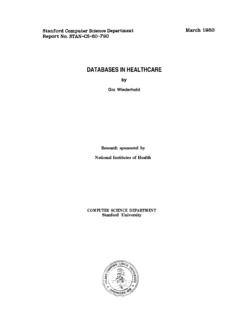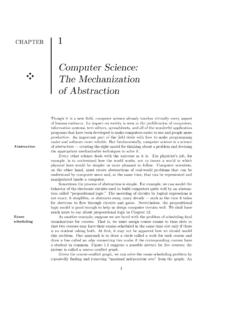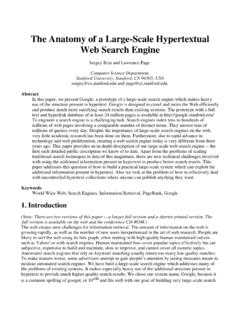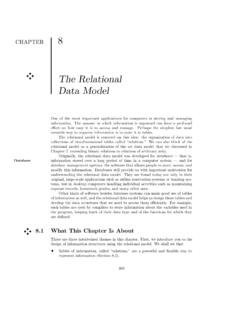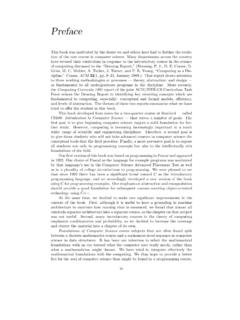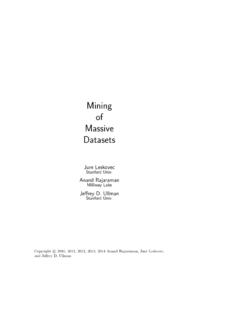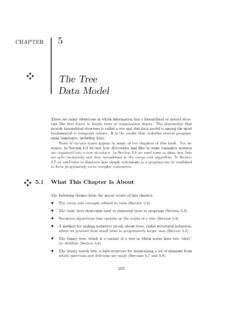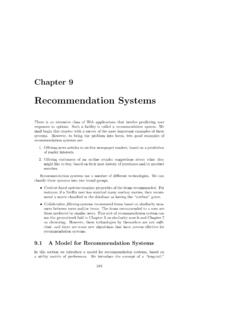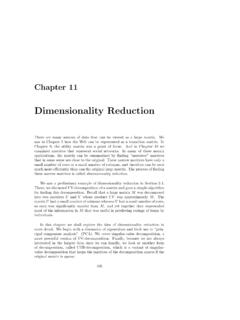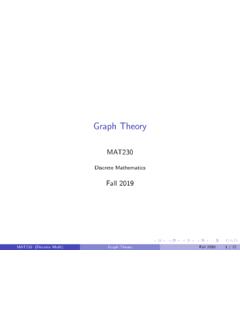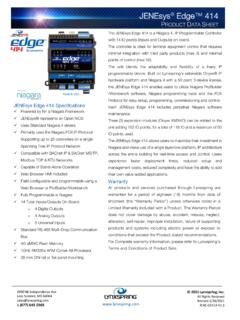Transcription of The Graph Data Model - Stanford University
1 CHAPTER9FF FFThe GraphData ModelA Graph is, in a sense, nothing more than a binary relation. However, it has apowerful visualization as a set of points (called nodes) connected by lines (callededges) or by arrows (called arcs). In this regard, the Graph is a generalization of thetree data Model that we studied in Chapter 5. Like trees, graphs come in severalforms: directed/undirected, and like trees, graphs are useful in a wide spectrum of problems such as com-puting distances, finding circularities in relationships,and determining connectiv-ities. We have already seen graphs used to represent the structure of programs inChapter 2. Graphs were used in Chapter 7 to represent binary relations and toillustrate certain properties of relations, like commutativity.
2 We shall see graphsused to represent automata in Chapter 10 and to represent electronic circuits inChapter 13. Several other important applications of graphsare discussed in What This Chapter Is AboutThe main topics of this chapter areFThe definitions concerning directed and undirected graphs (Sections ).FThe two principal data structures for representing graphs:adjacency lists andadjacency matrices (Section ).FAn algorithm and data structure for finding the connected components of anundirected Graph (Section ).FA technique for finding minimal spanning trees (Section ).FA useful technique for exploring graphs, called depth-first search ( ).451452 THE Graph DATA MODELFA pplications of depth-first search to test whether a directed Graph has a cycle,to find a topological order for acyclic graphs, and to determine whether thereis a path from one node to another (Section ).
3 FDijkstra s algorithm for finding shortest paths (Section ). This algorithmfinds the minimum distance from one source node to every s algorithm for finding the minimum distance between any two nodes(Section ).Many of the algorithms in this chapter are examples of usefultechniques that aremuch more efficient than the obvious way of solving the given Basic ConceptsAdirected Graph ,consists ofDirected graph1. A setNofnodesand2. A binary relationAonN. We callAthe set ofarcsof the directed and arcsArcs are thus pairs of are drawn as suggested in Fig. Each node is represented by acircle, with the name of the node inside. We shall usually name the nodes byintegers starting at 0, or we shall use an equivalent enumeration. In Fig. , theset of nodes isN={0,1,2,3,4}.
4 Each arc (u, v) inAis represented by an arrow fromutov. In Fig. , theset of arcs isA={(0,0),(0,1),(0,2),(1,3),(2,0),(2,1) ,(2,4),(3,2),(3,4),(4,1)}01234 Fig. of a directed text, it is customary to represent an arc (u, v) asu v. We callvtheheadHead and tailof the arc anduthetailto conform with the notion thatvis at the head of CONCEPTS453arrow anduis at its tail. For example, 0 1 is an arc of Fig. ; its head is node1 and its tail is node 0. Another arc is 0 0; such an arc from a node to itself iscalled this arc, both the head and the tail are node and SuccessorsWhenu vis an arc, we can also say thatuis apredecessorofv, and thatvis asuccessorofu. Thus, the arc 0 1 tells us that 0 is a predecessor of 1 and that 1is a successor of 0. The arc 0 0 tells us that node 0 is both a predecessor and asuccessor of for trees, it is permissible to attach alabelto each node.
5 Labels will be drawnnear their node. Similarly, we can label arcs by placing the label near the middleof the arc. Any type can be used as a node label or an arc label. For instance, shows a node named 1, with a label dog, a node named 2, labeled cat, andan arc 1 2 labeled bites. 12bitesdogcatFig. labeled Graph with two as with trees, we should not confuse the name of a node with its names must be unique in a Graph , but two or more nodes can have the a directed Graph is a list of nodes (v1, v2, .. , vk) such that there is an arcfrom each node to the next, that is,vi vi+1fori= 1,2, .. , k 1. ThelengthLength of apathof the path isk 1, the number of arcs along the path. For example, (0,1,3) is apath of length two in Fig. trivial casek= 1 is permitted.
6 That is, any nodevby itself is a path oflength zero fromvtov. This path has no and Acyclic GraphsAcyclein a directed Graph is a path of length 1 or more that begins andends atthe same node. Thelength of the cycleis the length of the path. Note that a trivialLength of acyclepath of length 0 is not a cycle, even though it begins and endsat the same node. However, a path consisting of a single arcv vis a cycle of length the Graph of Fig. There is a cycle (0,0) of length 1because of the loop 0 0. There is a cycle (0,2,0) of length 2 because of the arcs0 2 and 2 0. Similarly, (1,3,2,1) is a cycle of length 3, and (1,3,2,4,1) is acycle of length Graph DATA MODELNote that a cycle can be written to start and end at any of its nodes. Thatis, the cycle (v1, v2.)
7 , vk, v1) could also be written as (v2, .. , vk, v1, v2) or asEquivalentcycles(v3, .. , vk, v1, v2, v3), and so on. For example, the cycle (1,3,2,4,1) could alsohave been written as (2,4,1,3,2).On every cycle, the first and last nodes are the same. We say that a cycle(v1, v2, .. , vk, v1) issimpleif no node appears more than once amongv1, .. , vk;Simple cyclethat is, the only repetition in a simple cycle occurs at the final the cycles in Example are simple. In Fig. thecycle (0,2,0) is simple. However, there are cycles that are not simple, such as(0,2,1,3,2,0) in which node 2 appears a nonsimple cycle containing nodev, we can find a simple cycle contain-ingv. To see why, write the cycle to begin and end atv, as in (v, v1, v2, .. , vk, v).If the cycle is not simple, then three or more times, or2.
8 There is some nodeuother thanvthat appears twice; that is, the cycle mustlook like (v, .. , u, .. , u, .. , v).In case (1), we can remove everything up to, but not including, the next-to-lastoccurrence ofv. The result is a shorter cycle fromvtov. In case (2), we can removethe section fromutou, replacing it by a single occurrence ofu, to get the cycle(v, .. , u, .. , v). The result must still be a cycle in either case, because each arc ofthe result is present in the original cycle, and therefore ispresent in the may be necessary to repeat this transformation several times before the cyclebecomes simple. Since the cycle always gets shorter with each iteration, eventuallywe must arrive at a simple cycle. What we have just shown is that if there is a cyclein a Graph , then there must be at least one simple the cycle (0,2,1,3,2,0), we can remove the first 2 and thefollowing 1,3 to get the simple cycle (0,2,0).
9 In physical terms, we started withthe cycle that begins at 0, goes to 2, then 1, then 3, back to 2, and finally back to0. The first time we are at 2, we can pretend it is the second time, skip going to 1and 3, and proceed right back to another example, consider the nonsimple cycle (0,0,0). As 0 appears threetimes, we remove the first 0, that is, everything up to but not including the next-to-last 0. Physically, we have replaced the path in which we went around the loop0 0 twice by the path in which we go around a Graph has one or more cycles, we say the Graph there are noCyclic graphcycles, the Graph is said to what we just argued about simple cycles,a Graph is cyclic if and only if it has a simple cycle, because if it has any cycles atall, it will have a simple mentioned in Section that we could represent the CONCEPTS455made by a collection of functions with a directed Graph called the calling Graph .
10 Calling graphThe nodes are the functions, and there is an arcP Qif functionPcalls functionQ. For instance, Fig. shows the calling Graph associated with the merge sortalgorithm of Section Graph for the mergesort existence of a cycle in the calling Graph implies a recursion in the Fig. there are four simple cycles, one around each of the nodesMakeList,MergeSort,split, andmerge. Each cycle is a trivial loop. Recall that all thesefunctions call themselves, and thus are recursive. Recursions in which a functioncalls itself are by far the most common kind, and each of theseappears as a loop inthe calling Graph . We call these , one occasionally sees anDirect andindirectrecursionindirectrecursion, in which there is a cycle of length greater than instance,the graphPQRrepresents a functionPthat calls functionQ, which calls functionR, which Graph DATA MODELA cyclic PathsA path is said to beacyclicif no node appears more than once on the path.

